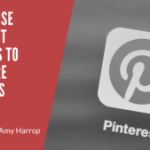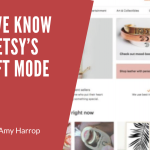Anybody who reads this blog regularly knows that Pinterest is one of the best places to sell products. Pinterest users love to use their accounts to find unique items to give as gifts or to buy for themselves. Promoting your products there makes sense.
One tool that you may not be using is the Rich Pin feature on Pinterest. Here’s what you need to know about Rich Pins and how to use them to sell more products.
What is a Rich Pin?
Let’s start with the basics. A Rich Pin is a pin that includes metadata that’s pulled directly from your product listings. Here’s how Pinterest defines Rich Pins.
Rich Pins show metadata right on the Pin itself, giving Pinners a richer experience and increasing engagement. Information in a Rich Pin is independent of the Pin description, ensuring that important information is always tied to the Pin. There are 4 types of Rich Pins: app, article, product, and recipe Pins.
Rich Pins work by displaying metadata from marked up pages on your website. Once you’ve applied for Rich Pins, any content on your site with metadata will turn into a Rich Pin when a user saves it.
The primary benefit of using Rich Pins is that they offer detailed information about your products, making it easier for customers to decide to buy them.
How to Apply for Rich Pins
Now that you understand what Rich Pins are and why you should be using them, let’s talk about how to get them. Pinterest requires users to apply for Rich Pins.
The first and most complex step to get Rich Pins is adding metadata to your site. In the case of your personal website, you have multiple options, including Open Graph, oEmbed, and Schema.org markup. These all require you to add code to the pages you want to Pin. You can find detailed instructions on the Product Rich Pin page, which you can access by clicking here.
If you want to add metadata to your Etsy page, you’ll need to use the Schema.org option. You’ll need the following information.
- The canonical URL for the page
- A JSON list of dictionaries with product fields (product fields include price, currency code, title, description, offer ID, availability, quantity, standard price (required if a product is on sale), sale start date, sale end date, and geographic availability.
- Product description
- Product brand
- Product gender (for apparel, e.g., men, women, children, unisex)
- Images
- Product expiration, if applicable
- Color
- Ratings
It’s important to note here that only the URL and JSON list are required. Everything else is optional. You should keep in mind that including additional data, such as product descriptions, colors, and product ratings, can help you appeal directly to people in your target audience and sell more products.
The next step is to paste the URL of one of the pages to which you have added metadata into the Pinterest Rich Pin validator and check it for errors. The validator will let you know if you have made any mistakes with the metadata.
Once you have corrected all the mistakes, you’ll choose one of three options to indicate how you have marked up your data: HTML for Open Graph or Schema.org, oEmbed for (you guessed it) oEmbed, or Shopify if you have a Shopify store. Then, simply click the Apply Now button.
The good news is that you only need to apply once to qualify for Rich Pins on every page on your domain. You’ll still need to mark up each product page individually. Just make sure to use the same protocols you used for the first page, and you shouldn’t have any problems getting Rich Pins to work on your page.
How to Make the Most of Rich Pins for Your Products
After you’ve added metadata to your product pages and applied for Rich Pins, it’s time to take advantage of your new, data-rich images. Here are some pointers.
- First, make sure to take the time to create a compelling title/headline for each one of your Pins. While the metadata will add information, it won’t automatically make a Pin more appealing to your followers or to casual browsers.
- Second, add a compelling description to each post. If you’re linking to a page with a full product description, the Rich Pin will automatically display the first couple of lines of your product page if you don’t add a meta description.
- Third, choose the right keywords. Remember that the first few words of your title and description are what most searchers will see unless they click on the Pin itself. You can use the same keywords that you used on your Etsy product description, or you can use Pinterest’s search feature to identify new keywords to help people find your products.
- Fourth, add a call to action. Why should people click on your Pin? What will they find if they do? A good example would be something like, “Buy from Store Name.”
When you get started with Rich Pins, you should make sure to review them carefully when they first appear on your Pinterest page. Check to ensure that the product image looks the way you want it to look and that the information you want displayed is there.
There may be a bit of trial and error with your first Rich Pin. However, as you get accustomed to adding metadata and creating Rich Pins, it will get easier. Before long, you won’t even need to think about it because it will just come naturally to you.
Conclusion
Pinterest is a powerful marketing tool for printables and POD products. While it does require a bit of work up front, the benefits of using Rich Pins are undeniable – and they can help you to attract more customers to your store and increase your sales.
Do you need help putting Pinterest marketing to work for you and increasing sales for your online store? Click here to work with me!



